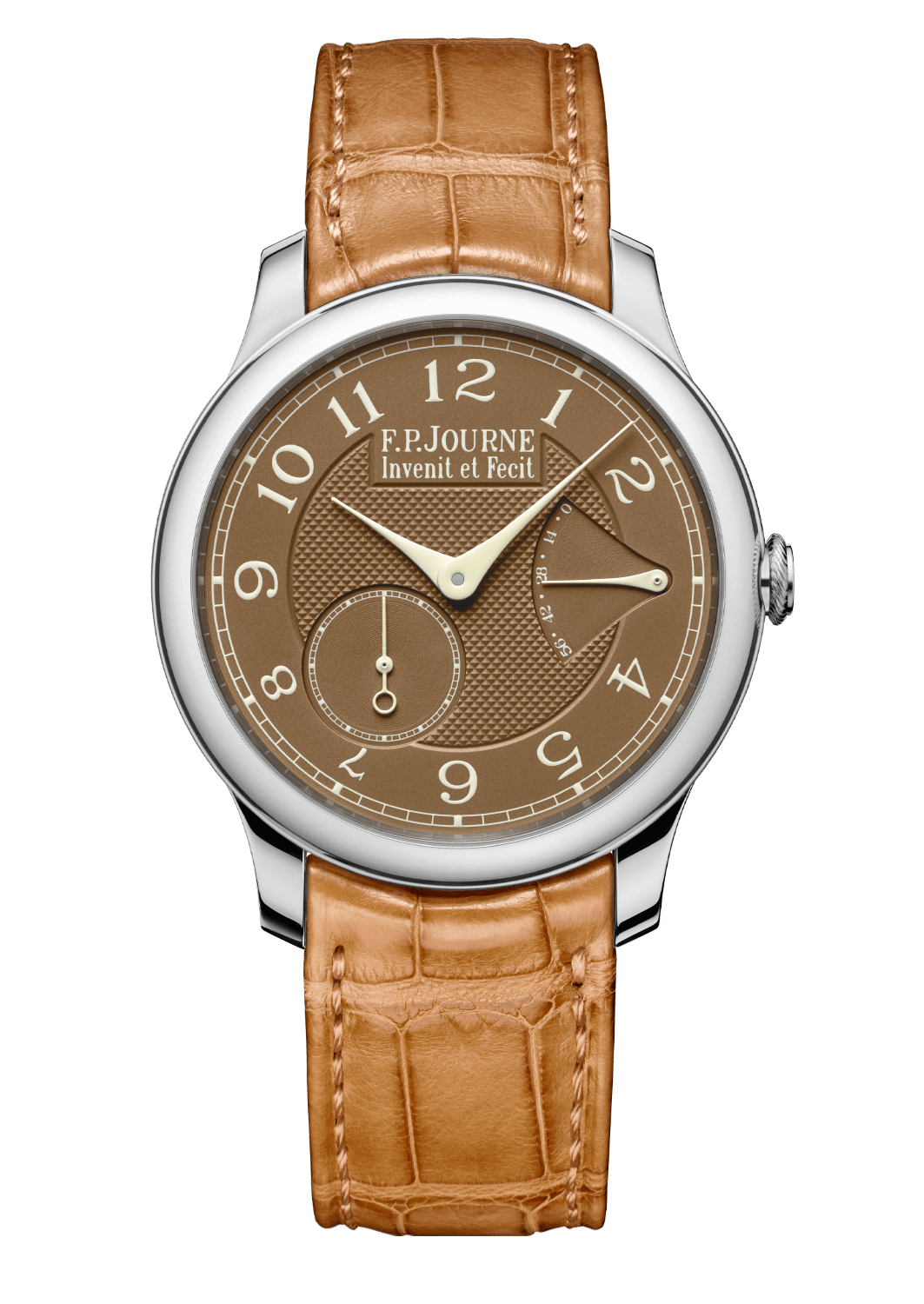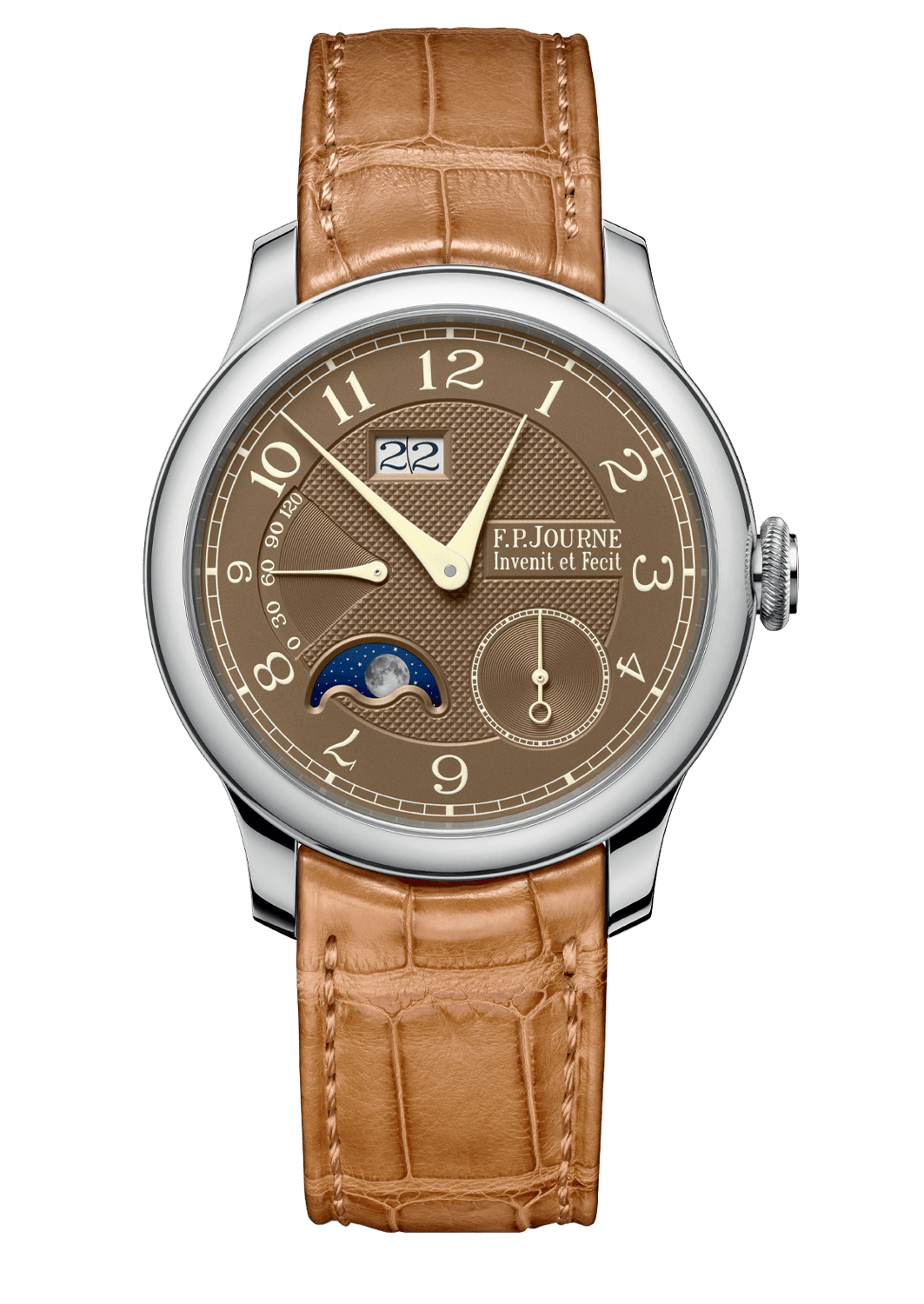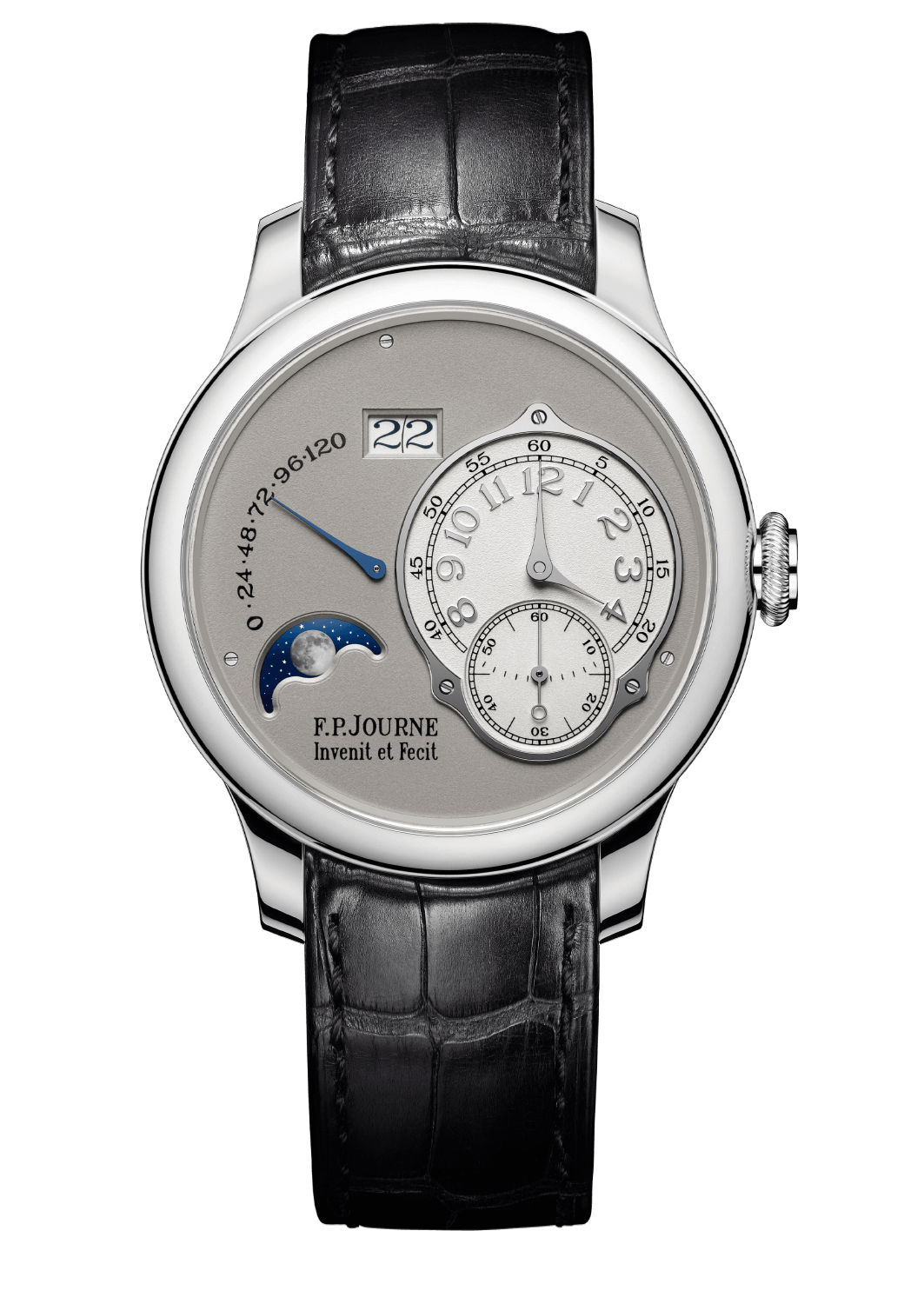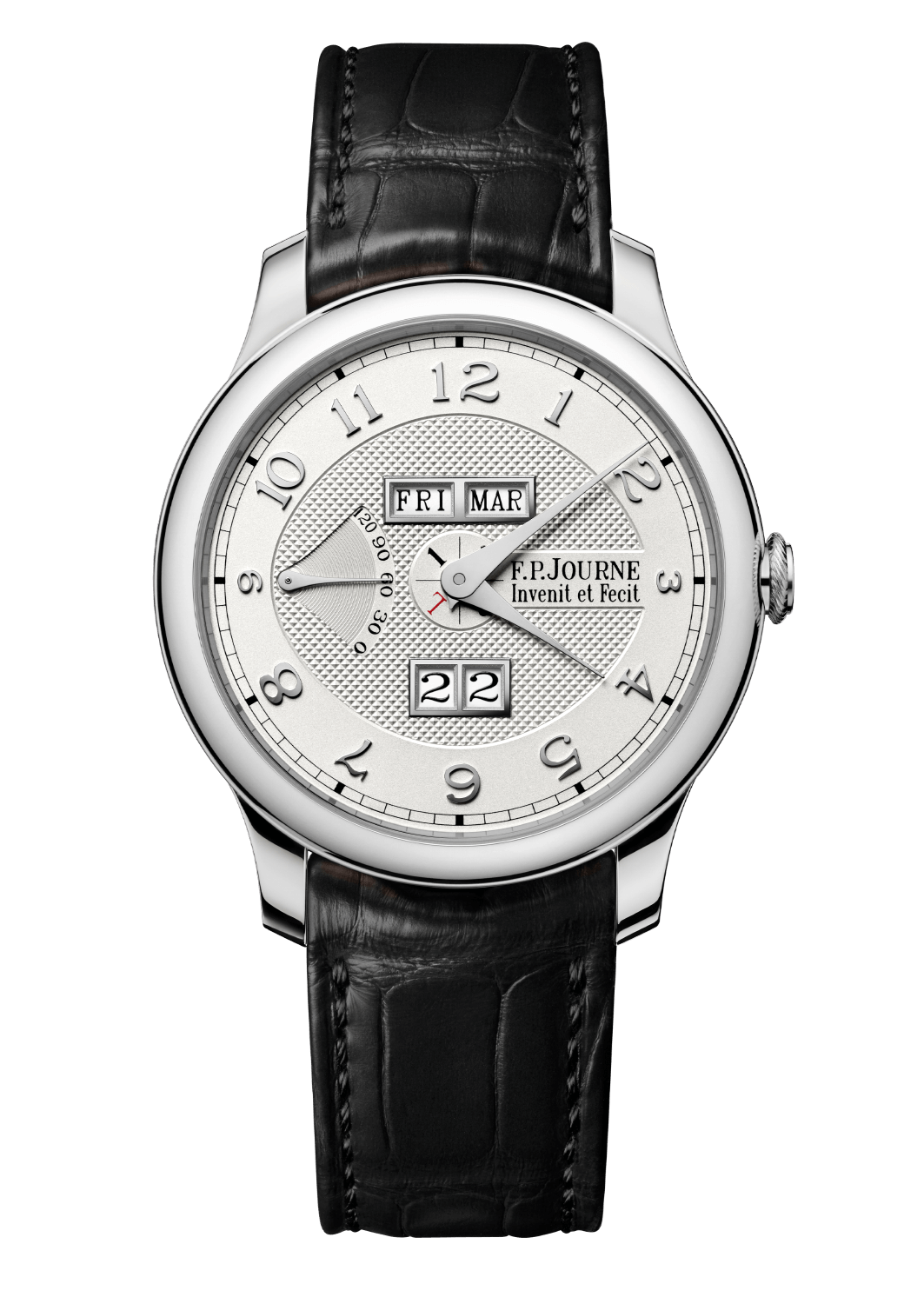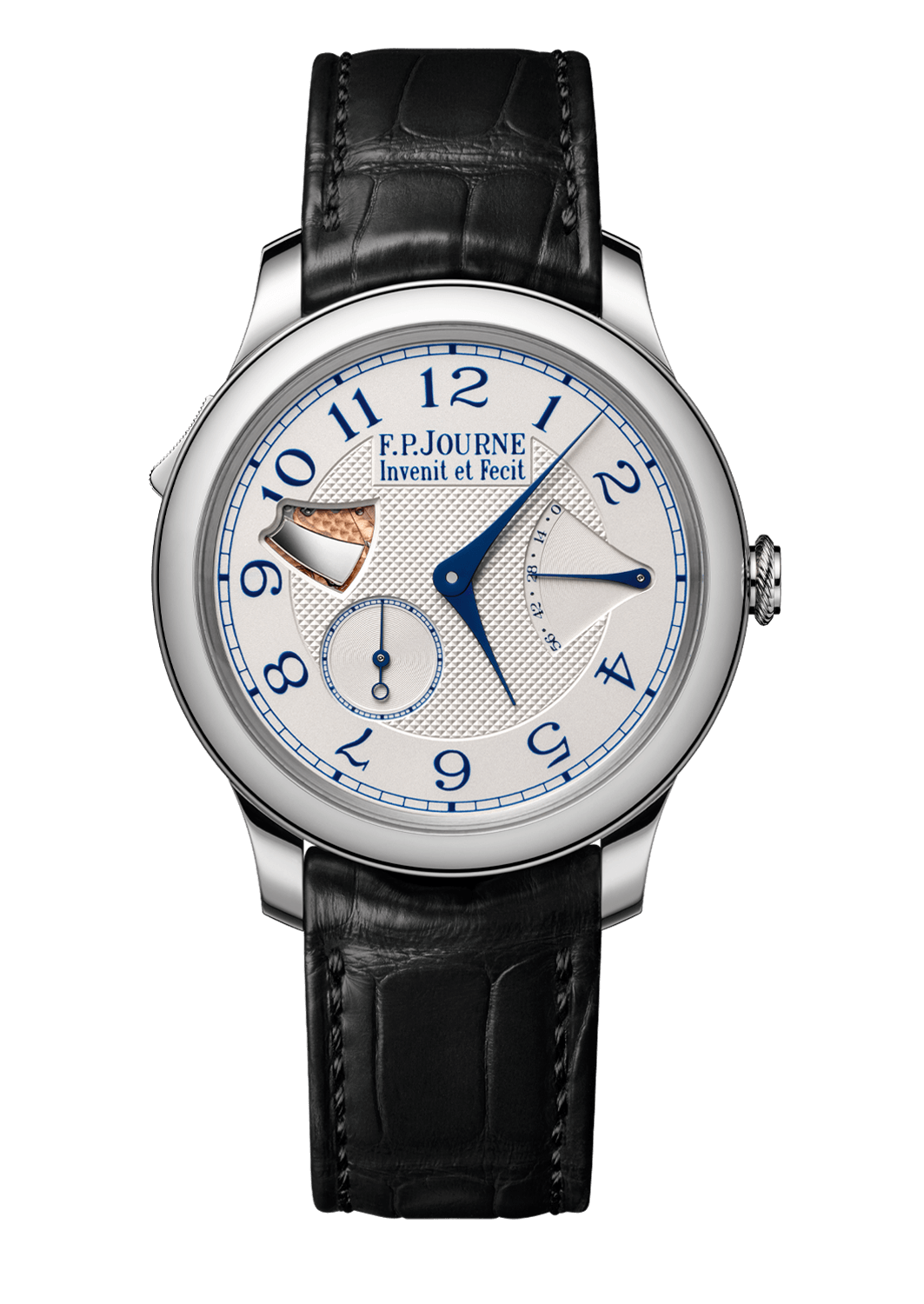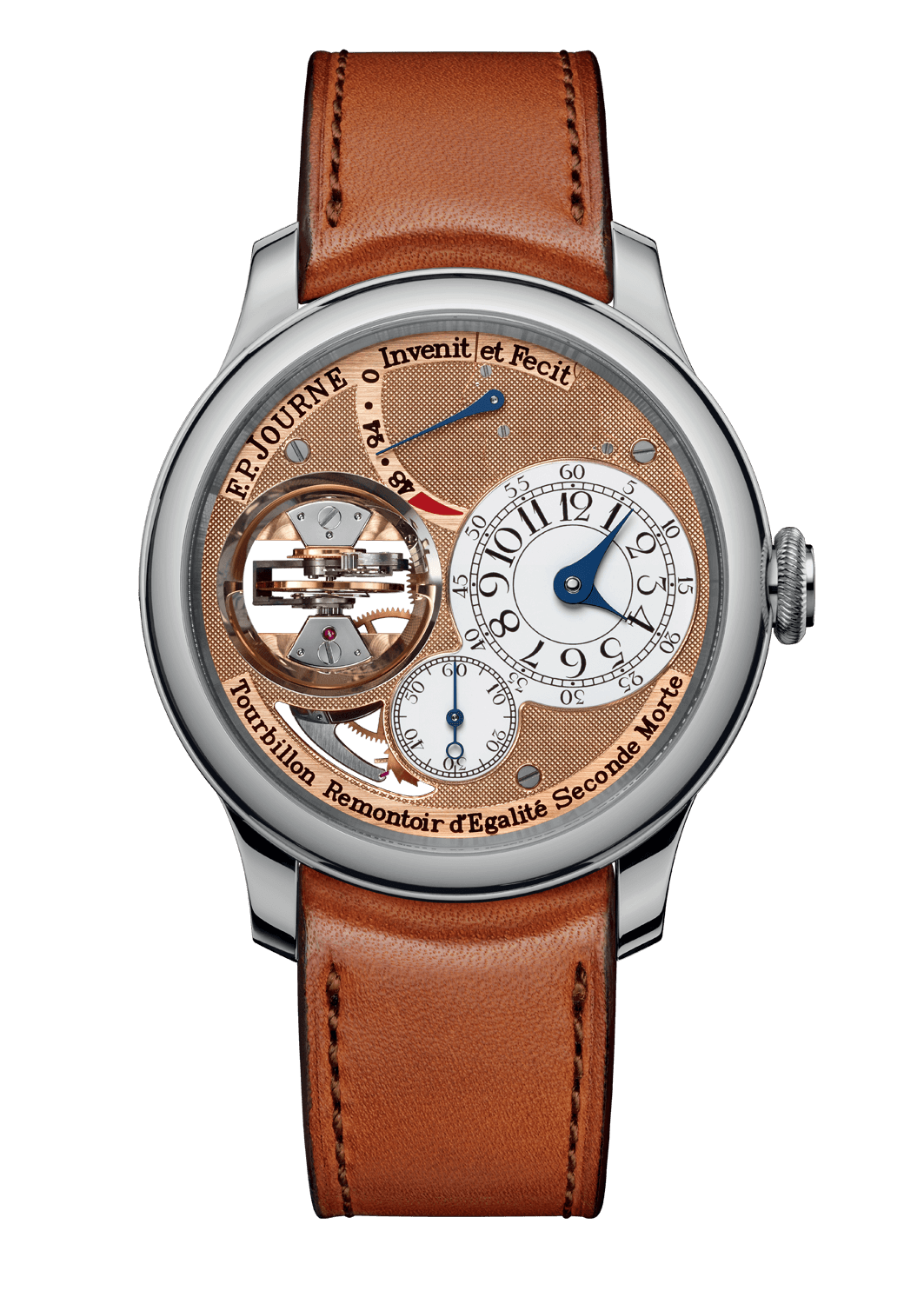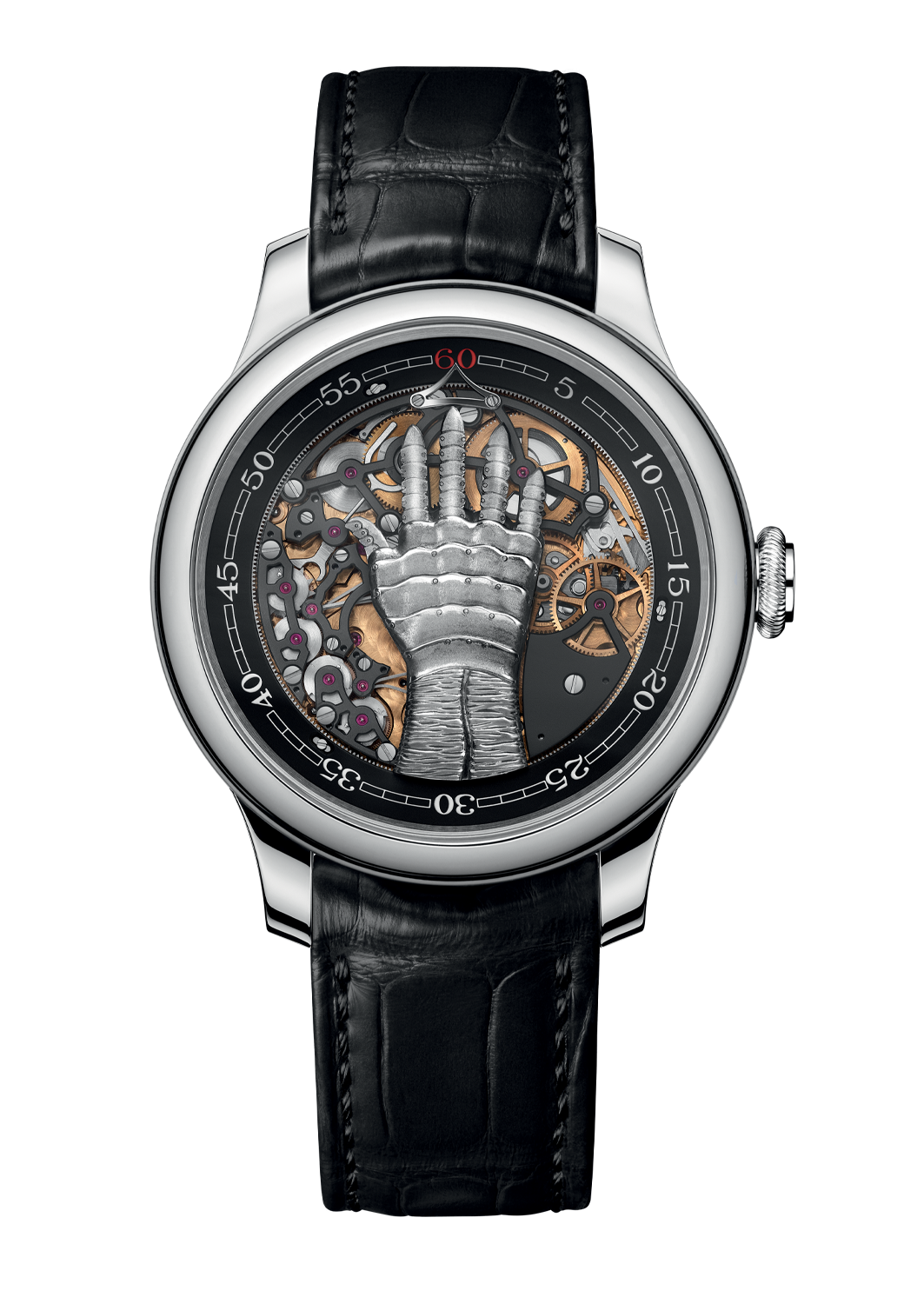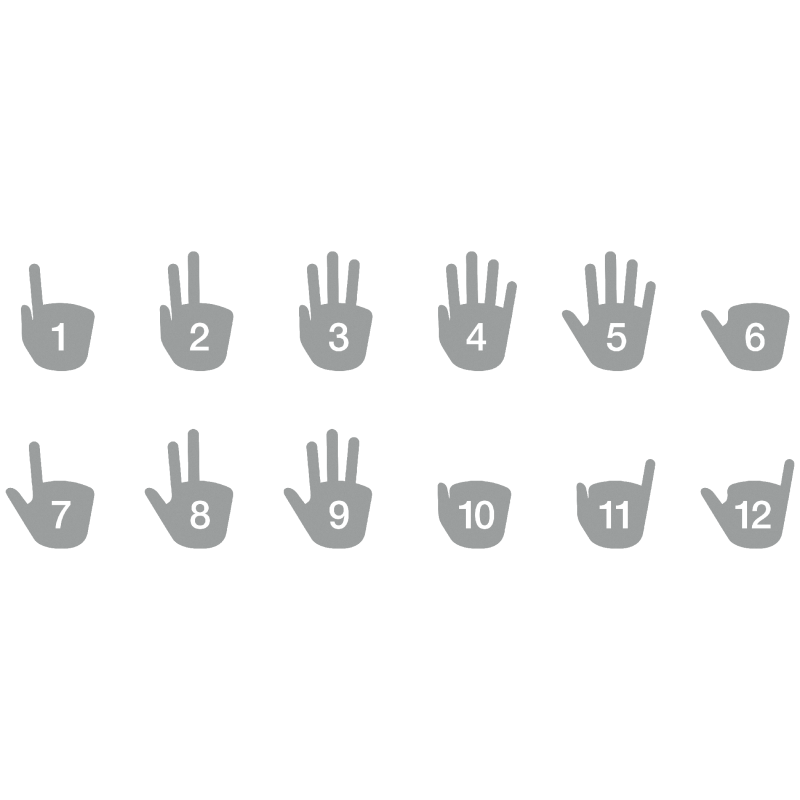Calibre 1300.3 https://www.fpjourne.com/en/collection/classique-collection/ffc FP Journe https://www.fpjourne.com/en FP Journe

Diameter: 42 mm
Overall height: 10.7 mm
Instantaneous digital hours indicated by the animated fingers of a Titanium hand, rotating minutes dial
Technical Specifications
Instantaneous digital hours
Minutes on rotating dial
- Overall diameter : 34.20 mm
- Casing-up diameter : 30.40 mm
- Overall height : 8.10 mm
- Height of winding stem : 3.28 mm
- Diameter of stem thread : S1.20 mm
- Case diameter : 42.00 mm
- Overall thickness : 10.80 mm
In-line lever escapement, 15-tooth wheel
Balance with 4 inertia weights
Flat Anachron microflamed spring
Mobile stud holder
Free-sprung balance
Virolage laser Nivatronic
Pinned GE stud
Three-position crown
Slipping mainspring
Off-centre winding rotor
on rotator:
274 clockwise revolutions / 24 hours
Uni-directional automatic winding
Time setting with crown in position 2
21600 VPH, 3 Hz
Inertia : 10.10 mg*cm2
Angle of lift : 52°
12h dial up : 280°
90h dial up : 220°
120 ± 12 hours
63
High grade
Circular stripes on the bridges
Titanium bridges with Titalyt® coating
Baseplate partly circular grained
Polished screw heads with chamfered slots
Pegs with polished rounded ends
Steelwork with polished chamfers
Movement : 396
Cased on leather strap : 436
Instantaneous digital hours
Minutes on rotating dial
- Overall diameter : 34.20 mm
- Casing-up diameter : 30.40 mm
- Overall height : 8.10 mm
- Height of winding stem : 3.28 mm
- Diameter of stem thread : S1.20 mm
- Case diameter : 42.00 mm
- Overall thickness : 10.80 mm
In-line lever escapement, 15-tooth wheel
Balance with 4 inertia weights
Flat Anachron microflamed spring
Mobile stud holder
Free-sprung balance
Virolage laser Nivatronic
Pinned GE stud
Three-position crown
Slipping mainspring
Off-centre winding rotor
on rotator:
274 clockwise revolutions / 24 hours
Uni-directional automatic winding
Time setting with crown in position 2
21600 VPH, 3 Hz
Inertia : 10.10 mg*cm2
Angle of lift : 52°
12h dial up : 280°
90h dial up : 220°
120 ± 12 hours
63
High grade
Circular stripes on the bridges
Titanium bridges with Titalyt® coating
Baseplate partly circular grained
Polished screw heads with chamfered slots
Pegs with polished rounded ends
Steelwork with polished chamfers
Movement : 396
Cased on leather strap : 436
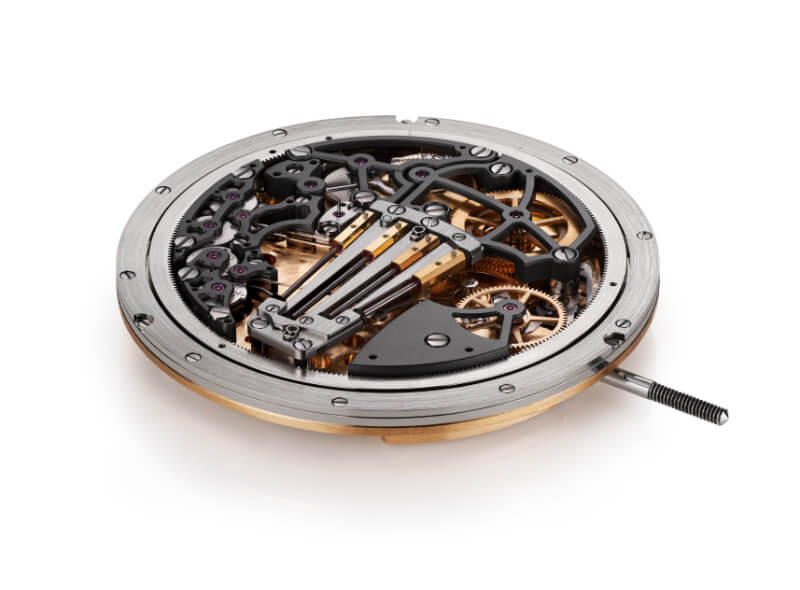
Technical description

Technical description
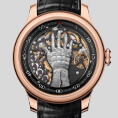
Diameter: 42 mm
Overall height: 10.7 mm
Instantaneous digital hours indicated by the animated fingers of a Titanium hand, rotating minutes dial
Technical Specifications
Instantaneous digital hours
Minutes on rotating dial
- Overall diameter : 34.20 mm
- Casing-up diameter : 30.40 mm
- Overall height : 8.10 mm
- Height of winding stem : 3.28 mm
- Diameter of stem thread : S1.20 mm
- Case diameter : 42.00 mm
- Overall thickness : 10.80 mm
In-line lever escapement, 15-tooth wheel
Balance with 4 inertia weights
Flat Anachron microflamed spring
Mobile stud holder
Free-sprung balance
Virolage laser Nivatronic
Pinned GE stud
Three-position crown
Slipping mainspring
Off-centre winding rotor
on rotator:
274 clockwise revolutions / 24 hours
Uni-directional automatic winding
Time setting with crown in position 2
21600 VPH, 3 Hz
Inertia : 10.10 mg*cm2
Angle of lift : 52°
12h dial up : 280°
90h dial up : 220°
120 ± 12 hours
63
High grade
Circular stripes on the bridges
Titanium bridges with Titalyt® coating
Baseplate partly circular grained
Polished screw heads with chamfered slots
Pegs with polished rounded ends
Steelwork with polished chamfers
Movement : 396
Cased on leather strap : 436
Instantaneous digital hours
Minutes on rotating dial
- Overall diameter : 34.20 mm
- Casing-up diameter : 30.40 mm
- Overall height : 8.10 mm
- Height of winding stem : 3.28 mm
- Diameter of stem thread : S1.20 mm
- Case diameter : 42.00 mm
- Overall thickness : 10.80 mm
In-line lever escapement, 15-tooth wheel
Balance with 4 inertia weights
Flat Anachron microflamed spring
Mobile stud holder
Free-sprung balance
Virolage laser Nivatronic
Pinned GE stud
Three-position crown
Slipping mainspring
Off-centre winding rotor
on rotator:
274 clockwise revolutions / 24 hours
Uni-directional automatic winding
Time setting with crown in position 2
21600 VPH, 3 Hz
Inertia : 10.10 mg*cm2
Angle of lift : 52°
12h dial up : 280°
90h dial up : 220°
120 ± 12 hours
63
High grade
Circular stripes on the bridges
Titanium bridges with Titalyt® coating
Baseplate partly circular grained
Polished screw heads with chamfered slots
Pegs with polished rounded ends
Steelwork with polished chamfers
Movement : 396
Cased on leather strap : 436

Technical description

Technical description
Diameter: 42 mm
Overall height: 10.7 mm
Instantaneous digital hours indicated by the animated fingers of a Titanium hand, rotating minutes dial

Diameter: 42 mm
Overall height: 10.7 mm
Instantaneous digital hours indicated by the animated fingers of a Titanium hand, rotating minutes dial
Technical Specifications
Instantaneous digital hours
Minutes on rotating dial
- Overall diameter : 34.20 mm
- Casing-up diameter : 30.40 mm
- Overall height : 8.10 mm
- Height of winding stem : 3.28 mm
- Diameter of stem thread : S1.20 mm
- Case diameter : 42.00 mm
- Overall thickness : 10.80 mm
In-line lever escapement, 15-tooth wheel
Balance with 4 inertia weights
Flat Anachron microflamed spring
Mobile stud holder
Free-sprung balance
Virolage laser Nivatronic
Pinned GE stud
Three-position crown
Slipping mainspring
Off-centre winding rotor
on rotator:
274 clockwise revolutions / 24 hours
Uni-directional automatic winding
Time setting with crown in position 2
21600 VPH, 3 Hz
Inertia : 10.10 mg*cm2
Angle of lift : 52°
12h dial up : 280°
90h dial up : 220°
120 ± 12 hours
63
High grade
Circular stripes on the bridges
Titanium bridges with Titalyt® coating
Baseplate partly circular grained
Polished screw heads with chamfered slots
Pegs with polished rounded ends
Steelwork with polished chamfers
Movement : 396
Cased on leather strap : 436
Instantaneous digital hours
Minutes on rotating dial
- Overall diameter : 34.20 mm
- Casing-up diameter : 30.40 mm
- Overall height : 8.10 mm
- Height of winding stem : 3.28 mm
- Diameter of stem thread : S1.20 mm
- Case diameter : 42.00 mm
- Overall thickness : 10.80 mm
In-line lever escapement, 15-tooth wheel
Balance with 4 inertia weights
Flat Anachron microflamed spring
Mobile stud holder
Free-sprung balance
Virolage laser Nivatronic
Pinned GE stud
Three-position crown
Slipping mainspring
Off-centre winding rotor
on rotator:
274 clockwise revolutions / 24 hours
Uni-directional automatic winding
Time setting with crown in position 2
21600 VPH, 3 Hz
Inertia : 10.10 mg*cm2
Angle of lift : 52°
12h dial up : 280°
90h dial up : 220°
120 ± 12 hours
63
High grade
Circular stripes on the bridges
Titanium bridges with Titalyt® coating
Baseplate partly circular grained
Polished screw heads with chamfered slots
Pegs with polished rounded ends
Steelwork with polished chamfers
Movement : 396
Cased on leather strap : 436

Technical description

Technical description

Diameter: 42 mm
Overall height: 10.7 mm
Instantaneous digital hours indicated by the animated fingers of a Titanium hand, rotating minutes dial
Technical Specifications
Instantaneous digital hours
Minutes on rotating dial
- Overall diameter : 34.20 mm
- Casing-up diameter : 30.40 mm
- Overall height : 8.10 mm
- Height of winding stem : 3.28 mm
- Diameter of stem thread : S1.20 mm
- Case diameter : 42.00 mm
- Overall thickness : 10.80 mm
In-line lever escapement, 15-tooth wheel
Balance with 4 inertia weights
Flat Anachron microflamed spring
Mobile stud holder
Free-sprung balance
Virolage laser Nivatronic
Pinned GE stud
Three-position crown
Slipping mainspring
Off-centre winding rotor
on rotator:
274 clockwise revolutions / 24 hours
Uni-directional automatic winding
Time setting with crown in position 2
21600 VPH, 3 Hz
Inertia : 10.10 mg*cm2
Angle of lift : 52°
12h dial up : 280°
90h dial up : 220°
120 ± 12 hours
63
High grade
Circular stripes on the bridges
Titanium bridges with Titalyt® coating
Baseplate partly circular grained
Polished screw heads with chamfered slots
Pegs with polished rounded ends
Steelwork with polished chamfers
Movement : 396
Cased on leather strap : 436
Instantaneous digital hours
Minutes on rotating dial
- Overall diameter : 34.20 mm
- Casing-up diameter : 30.40 mm
- Overall height : 8.10 mm
- Height of winding stem : 3.28 mm
- Diameter of stem thread : S1.20 mm
- Case diameter : 42.00 mm
- Overall thickness : 10.80 mm
In-line lever escapement, 15-tooth wheel
Balance with 4 inertia weights
Flat Anachron microflamed spring
Mobile stud holder
Free-sprung balance
Virolage laser Nivatronic
Pinned GE stud
Three-position crown
Slipping mainspring
Off-centre winding rotor
on rotator:
274 clockwise revolutions / 24 hours
Uni-directional automatic winding
Time setting with crown in position 2
21600 VPH, 3 Hz
Inertia : 10.10 mg*cm2
Angle of lift : 52°
12h dial up : 280°
90h dial up : 220°
120 ± 12 hours
63
High grade
Circular stripes on the bridges
Titanium bridges with Titalyt® coating
Baseplate partly circular grained
Polished screw heads with chamfered slots
Pegs with polished rounded ends
Steelwork with polished chamfers
Movement : 396
Cased on leather strap : 436

Technical description

Technical description
About
Switching to digital time
In anticipation of the production of a small series of a timepiece inspired by the FFC Blue prototype, a unique piece for Only Watch 2021, it seems useful to revisit its genesis and its unique way of reading the time, made possible by a hand whose fingers come to life as the hours pass.
The story of how the FFC Blue was created is like a fairy tale and for this reason deserves to be told again for those who do not know it. It began in 2009 when Mrs. Eleanor Coppola, Francis Ford Coppola’s wife, gave her illustrious filmmaker husband the Chronomètre à Résonance, which she found chic and elegant. Delighted with the gift, he immediately sent an invitation to its creator to come and meet him at his “Inglenook” winery in the Napa Valley. When they met in 2012, they discussed the different principles of representing the passing of time and the filmmaker asked if a watchmaker had ever considered displaying the hours in the way the ancients used to give them, by counting them on their fingers. The idea of ticking the 12 digits of the hours with 5 fingers had appealed to François-Paul who, in 2014, wanted to take up the challenge of inventing an animated hand capable of displaying it in the same way. His motivation led him to start prototyping the FFC Blue watch the same year, which was supposed to go on sale at Only Watch 2021.
HISTORY IN MOTION
After having found, with Francis Ford Coppola, how to present the 12 digits of the hours with a single hand and 5 fingers, François-Paul set out to design a mechanism capable of adequately transcribing these digits into digital signs. To avoid falling into naturalism, this artist, who is known to have a passion for history, like one of his sons who today is a professional historian, chose to draw his inspiration from a drawing of a prosthesis made by the famous French barber-surgeon Ambroise Paré (1509/1510-1590).
For those not familiar with him, he is the one to whom we owe, thanks to his competence and understanding of the human body, undeniable progress in medicine. The mechanised hand found on the front of the FFC Blue is inspired by the one developed by this Renaissance physician.
Initially thought in bronze by its inventor, the final hand for the watch was made of engraved titanium, used to reduce the weight of the moving components so as to not affect the energy consumption of the caliber, the Octa 1300.3 launched by the Manufacture F.P.Journe in 2001. As François-Paul points out, “The most important thing in watchmaking is what is least visible. In this case, it was a matter of getting five fingers to move with the least amount of effort”
MANAGING THE AVAILABLE ENERGY
In order to use only the energy coming from the barrel, which ensures a power reserve of 5 days for the piece, the choice was made to install a “remontoir d’égalité” between the primary gear train and the display, as is done in the clocks of buildings when the hands to be moved are long and heavy. Every hour, and for 40 minutes, the “remontoir d’égalité”, formed by a spring blade enclosed in a kind of barrel, a trigger and a sort of anchor mounted on one side on a wheel with an eccentric in its center, is rewound by the movement.
On the hour, the mechanism described by François-Paul as a sort of escapement acting once an hour, is released so that the energy accumulated from the main barrel can, through the intermediary of this tangentially acting fork, set in motion the series of 10 cams whose purpose is to control the movement of the fingers of the hand. Placed on the left side and visible between the rotating minute ring mounted on a large extra-flat ball bearing with a fixed cursor placed at noon, they make one revolution in 12 hours, each one activating a series of springs and toggles acting on the rise and fall of the 4 fingers, but also the translation of the thumb. The shape of the cams, associated with the teeth of each one, acts on the fingers which are mounted on a steel sling and which move then, practically without friction, like a loom shuttle. Thanks to this ingenious system, the energy required to operate one finger, four fingers between 5 and 6 o’clock as well as between 9 and 10 o’clock, is always the same and calibrated so that it is done in complete safety and, above all, without affecting the chronometry of the regulating group.
REINVENTING HOW TIME IS DISPLAYED
By means of miniaturisation work pushed to the extreme and seven years of incessant labor spent making the whole thing reliable, the master, supported by the skills gathered within his manufacture, has managed to integrate all the components of the automatic caliber and this astonishing anthropomorphic mobile into a case measuring 42 mm in diameter and only 10.7 mm thick. As a result, despite the complexity of the whole, this watch is no thicker than another model equipped with the same movement. To achieve this exploit, François-Paul eliminated the dial and replaced the minute hand, which was impossible to use in the traditional way, with a rotating ring mounted on a large extra-flat ball bearing, as he did for the annual calendar of the Astronomic Souveraine. This modification made it possible to gain the few millimeters necessary for the placement of the articulated hand sculpted by a master engraver. So, in the end, what does this high-flying timepiece bring to the table besides its original display? It proves that the best way to make a complicated watch is to think about how to save energy in order to make it work without having to add any. As François-Paul says, the watchmaker must have a light hand when designing a movement.
In the end, the Octa caliber is perfect for this approach because it has a constant and linear force and torque for 5 days. By optimising the friction and using only the smoothest part of the spring, we find a very linear torque that allows adding functions without being afraid that everything will stop. Here’s the proof!
As the saying goes, Fortune favors the bold. Who could have imagined that the young Ambroise Paré, who came from a modest barber’s family and began practicing that profession before he was fifteen in his native village of Laval (300 km west of Paris), would become the first royal surgeon, introducing many important medical innovations?
The Hand of the Apprentice
At the time, barbers dealt with hair, skin, and blood, as well as simple medical treatments. This, however, was not enough for the young Ambroise Paré! He dreamed of greater things. A hard worker with a quick and creative mind, he defied the social constraints of the time and took charge of his own destiny by becoming a surgeon!
Consequently he travelled to Paris, where the renowned Hôtel-Dieu hospital was located. It was one of the most important medical centers in the kingdom. There Paré studied anatomy by practicing on cadavers, learned the correct dosages of medicine, and assisted barber surgeons. For three years (1533-1536), he worked hard, learned a great deal, and was highly respected by his fellow students...
Unfortunately, he knew neither Greek nor Latin, which was inconceivable for a barber surgeon! At the age of twenty-six he failed the examination for a barber surgeon’s degree due to his inability to answer a theoretical question, despite the fact that medicine is an empirical art. That did not discourage him, however! He decided to seek advancement through an entirely different avenue: a military career…
The Hand of the Surgeon
Supremely pragmatic, in 1536 Paré enrolled in the army as a barber surgeon – without having passed the exam – to the French army. He realized this was the best way to seek advancement while serving others. At the time Europe was embroiled in a long war between the two major powers of the day - the kingdoms of France (ruled by Francis I) and Spain (ruled by Charles V).
This experience led Paré to realize that medicine as it was traditionally taught was powerless to heal the kinds of wounds created by the revolutionary new weapons that had come into use. The harquebus was a sort of cannon that was carried on the shoulder, and whose bullets smashed, crushed, and burned victims’ bodies… The teachings of the great physicians of antiquity (Hippocrates and Galen) were made obsolete by this new weapon… Paré explained that these new types of wounds should not be treated, as was the custom, with boiling oil followed by the application of a red-hot iron. He understood that after the removal of the bullets, the wound’s inflammation had to be reduced by using new sorts of balms and soothing ointments, in order to lessen the risk of septicemia. In 1542 he invented new tools to remove the projectiles. Thus, his creative genius first became noticeable on the battlefield…
His fame grew even more when, in 1545, he published his first book in French: Les méthodes pour soigner les plaies par arquebuses (Methods for treating wounds caused by harquebuses). He revolutionized classical medicine, and went even further by rejecting Latin, which was then the language of medicine… He was, in fact, thumbing his nose at the Faculty of Medicine, and was not the last to do so. That same year Francis I died and was succeeded by his son Henry II, who pursued the war with Spain.
During the campaign of 1552 he introduced an innovation that was perhaps his most important and the major source of his medical reputation: the ligature of arteries and veins after amputation. There would be no more cauterizations or frequent septicemia! Ambroise Paré became the “Father of Modern Surgery”!
Due to the support of Henry II and the nobility, in 1554 he became a royal surgeon and then received the title of Surgeon from the Faculty, which was eager to please the king.
The Hand of the Courtier
At court Paré showed himself to be a remarkable strategist, in order to advance the cause of surgery. Nevertheless he was powerless to help when, on July 10, 1559, Henry II’s eye was pierced by the lance of Gabriel de Montgomery during a joust held to celebrate the recent peace treaty signed with Spain. Prince Francis II, who succeeded him, confirmed Paré in his functions. Unfortunately, the young king died in 1560 at the age of sixteen, despite the surgeon’s best attempts to save him.
These two unhappy accidents increased Paré’s desire to understand the causes of the two kings’ deaths. He carried out autopsies on their bodies – a great innovation – and thus became the father of forensic medicine. This novel practice made a great impression on the Queen Mother and regent Catherine de’ Medici. In 1561 she made him first royal surgeon, in the service of King Charles IX (the third son of Henry II).
Ambroise Paré lived during troubled times. The war between France and Spain lasted throughout the first half of the 16th century, ending only in 1559. It was followed by the Wars of Religion between French Catholics and Protestants, which began in 1560. The situation led the regent Catherine de’ Medici to suggest that the court become itinerant from January 1564 to May 1566. The idea was that by traveling through the cities of France, tensions and disagreements would be soothed by the presentation of King Charles IX to his subjects. Paré, the first royal surgeon, accompanied the cortege of dignitaries. Far from taking excessive pride in this distinction, he took advantage of the long journey to meet with, and learn from, many barber surgeons, bonesetters, and apothecaries.
The Hand of the Writer
The political and religious atmosphere became dire when the Saint Bartholomew massacre occurred on August 24, 1572 in Paris, where Ambroise Paré lived. The situation became even more chaotic in 1574, with the death of Charles IX. He was succeeded by Henry III (the fourth son of Henry II), who confirmed Paré as first royal surgeon and gave him two new appointments: valet de chambre and king’s councillor.
Now a sexagenarian, Paré would never again leave Paris. He decided to use his money and influence for the compilation of all the medical knowledge of his time. He wrote new treatises and modernized the older ones, all the while polishing his earlier works. The first edition of his Œuvres was published in 1575, in French so as to be accessible to all. The Faculty, which was not pleased, waged a campaign to hurt his reputation. He nevertheless had the support of King Henry III and thus benefited from a certain degree of protection from their petty acts. His Œuvres were reprinted several times: a 2nd edition appeared in 1579, a 3rd in 1582, and a 4th in 1585, while a 5th appeared posthumously in 1598. His Œuvres comprised twenty-nine volumes with 1228 large illustrated pages. The work is a remarkable compendium of 16th century medical knowledge.
The Hand of the Inventor
Throughout his career Paré was concerned with the well being of his patients. One example of this is his avant-garde attitude toward prosthetics. Certain of his inventions were due to esthetic considerations, an artificial eye that fit into the eye socket; a metal nose that was attached by strings, to follow the original shape of the face; ears made of boiled cardboard that were fixed to the existing cartilage.
He also invented artificial limbs, masterpieces of ingeniousness and technical knowledge. His prosthetic arms and legs are so mechanically complex that it would require many pages to do justice to them…
Mention should however be made of his prosthetic hand, with its quasi-horological design. The mechanism of the mechanical hand made the fingers open when a button was pressed, and two springs brought them back to their original position, as if the hand were closing naturally.
The prosthetic devices invented by Ambroise Paré remained important references from the 16th century until the First World War (1914-1918). Paré is considered to be the Father of modern surgery, thanks to his ingenious inventions and observations.
Charles Journe
Paris, September 2021
Technical Specifications
Instantaneous digital hours
Minutes on rotating dial
- Overall diameter : 34.20 mm
- Casing-up diameter : 30.40 mm
- Overall height : 8.10 mm
- Height of winding stem : 3.28 mm
- Diameter of stem thread : S1.20 mm
- Case diameter : 42.00 mm
- Overall thickness : 10.80 mm
In-line lever escapement, 15-tooth wheel
Balance with 4 inertia weights
Flat Anachron microflamed spring
Mobile stud holder
Free-sprung balance
Virolage laser Nivatronic
Pinned GE stud
Three-position crown
Slipping mainspring
Off-centre winding rotor
on rotator:
274 clockwise revolutions / 24 hours
Uni-directional automatic winding
Time setting with crown in position 2
21600 VPH, 3 Hz
Inertia : 10.10 mg*cm2
Angle of lift : 52°
12h dial up : 280°
90h dial up : 220°
120 ± 12 hours
63
High grade
Circular stripes on the bridges
Titanium bridges with Titalyt® coating
Baseplate partly circular grained
Polished screw heads with chamfered slots
Pegs with polished rounded ends
Steelwork with polished chamfers
Movement : 396
Cased on leather strap : 436
Instantaneous digital hours
Minutes on rotating dial
- Overall diameter : 34.20 mm
- Casing-up diameter : 30.40 mm
- Overall height : 8.10 mm
- Height of winding stem : 3.28 mm
- Diameter of stem thread : S1.20 mm
- Case diameter : 42.00 mm
- Overall thickness : 10.80 mm
In-line lever escapement, 15-tooth wheel
Balance with 4 inertia weights
Flat Anachron microflamed spring
Mobile stud holder
Free-sprung balance
Virolage laser Nivatronic
Pinned GE stud
Three-position crown
Slipping mainspring
Off-centre winding rotor
on rotator:
274 clockwise revolutions / 24 hours
Uni-directional automatic winding
Time setting with crown in position 2
21600 VPH, 3 Hz
Inertia : 10.10 mg*cm2
Angle of lift : 52°
12h dial up : 280°
90h dial up : 220°
120 ± 12 hours
63
High grade
Circular stripes on the bridges
Titanium bridges with Titalyt® coating
Baseplate partly circular grained
Polished screw heads with chamfered slots
Pegs with polished rounded ends
Steelwork with polished chamfers
Movement : 396
Cased on leather strap : 436

Technical description

Technical description
-
About
FFC
Switching to digital time
In anticipation of the production of a small series of a timepiece inspired by the FFC Blue prototype, a unique piece for Only Watch 2021, it seems useful to revisit its genesis and its unique way of reading the time, made possible by a hand whose fingers come to life as the hours pass.
The story of how the FFC Blue was created is like a fairy tale and for this reason deserves to be told again for those who do not know it. It began in 2009 when Mrs. Eleanor Coppola, Francis Ford Coppola’s wife, gave her illustrious filmmaker husband the Chronomètre à Résonance, which she found chic and elegant. Delighted with the gift, he immediately sent an invitation to its creator to come and meet him at his “Inglenook” winery in the Napa Valley. When they met in 2012, they discussed the different principles of representing the passing of time and the filmmaker asked if a watchmaker had ever considered displaying the hours in the way the ancients used to give them, by counting them on their fingers. The idea of ticking the 12 digits of the hours with 5 fingers had appealed to François-Paul who, in 2014, wanted to take up the challenge of inventing an animated hand capable of displaying it in the same way. His motivation led him to start prototyping the FFC Blue watch the same year, which was supposed to go on sale at Only Watch 2021.
HISTORY IN MOTION
After having found, with Francis Ford Coppola, how to present the 12 digits of the hours with a single hand and 5 fingers, François-Paul set out to design a mechanism capable of adequately transcribing these digits into digital signs. To avoid falling into naturalism, this artist, who is known to have a passion for history, like one of his sons who today is a professional historian, chose to draw his inspiration from a drawing of a prosthesis made by the famous French barber-surgeon Ambroise Paré (1509/1510-1590).
For those not familiar with him, he is the one to whom we owe, thanks to his competence and understanding of the human body, undeniable progress in medicine. The mechanised hand found on the front of the FFC Blue is inspired by the one developed by this Renaissance physician.
Initially thought in bronze by its inventor, the final hand for the watch was made of engraved titanium, used to reduce the weight of the moving components so as to not affect the energy consumption of the caliber, the Octa 1300.3 launched by the Manufacture F.P.Journe in 2001. As François-Paul points out, “The most important thing in watchmaking is what is least visible. In this case, it was a matter of getting five fingers to move with the least amount of effort”
MANAGING THE AVAILABLE ENERGY
In order to use only the energy coming from the barrel, which ensures a power reserve of 5 days for the piece, the choice was made to install a “remontoir d’égalité” between the primary gear train and the display, as is done in the clocks of buildings when the hands to be moved are long and heavy. Every hour, and for 40 minutes, the “remontoir d’égalité”, formed by a spring blade enclosed in a kind of barrel, a trigger and a sort of anchor mounted on one side on a wheel with an eccentric in its center, is rewound by the movement.
On the hour, the mechanism described by François-Paul as a sort of escapement acting once an hour, is released so that the energy accumulated from the main barrel can, through the intermediary of this tangentially acting fork, set in motion the series of 10 cams whose purpose is to control the movement of the fingers of the hand. Placed on the left side and visible between the rotating minute ring mounted on a large extra-flat ball bearing with a fixed cursor placed at noon, they make one revolution in 12 hours, each one activating a series of springs and toggles acting on the rise and fall of the 4 fingers, but also the translation of the thumb. The shape of the cams, associated with the teeth of each one, acts on the fingers which are mounted on a steel sling and which move then, practically without friction, like a loom shuttle. Thanks to this ingenious system, the energy required to operate one finger, four fingers between 5 and 6 o’clock as well as between 9 and 10 o’clock, is always the same and calibrated so that it is done in complete safety and, above all, without affecting the chronometry of the regulating group.
REINVENTING HOW TIME IS DISPLAYED
By means of miniaturisation work pushed to the extreme and seven years of incessant labor spent making the whole thing reliable, the master, supported by the skills gathered within his manufacture, has managed to integrate all the components of the automatic caliber and this astonishing anthropomorphic mobile into a case measuring 42 mm in diameter and only 10.7 mm thick. As a result, despite the complexity of the whole, this watch is no thicker than another model equipped with the same movement. To achieve this exploit, François-Paul eliminated the dial and replaced the minute hand, which was impossible to use in the traditional way, with a rotating ring mounted on a large extra-flat ball bearing, as he did for the annual calendar of the Astronomic Souveraine. This modification made it possible to gain the few millimeters necessary for the placement of the articulated hand sculpted by a master engraver. So, in the end, what does this high-flying timepiece bring to the table besides its original display? It proves that the best way to make a complicated watch is to think about how to save energy in order to make it work without having to add any. As François-Paul says, the watchmaker must have a light hand when designing a movement.
In the end, the Octa caliber is perfect for this approach because it has a constant and linear force and torque for 5 days. By optimising the friction and using only the smoothest part of the spring, we find a very linear torque that allows adding functions without being afraid that everything will stop. Here’s the proof!
-
Testimony
Ambroise Paré, a French Genius (1509/1510-1590)
As the saying goes, Fortune favors the bold. Who could have imagined that the young Ambroise Paré, who came from a modest barber’s family and began practicing that profession before he was fifteen in his native village of Laval (300 km west of Paris), would become the first royal surgeon, introducing many important medical innovations?
The Hand of the Apprentice
At the time, barbers dealt with hair, skin, and blood, as well as simple medical treatments. This, however, was not enough for the young Ambroise Paré! He dreamed of greater things. A hard worker with a quick and creative mind, he defied the social constraints of the time and took charge of his own destiny by becoming a surgeon!
Consequently he travelled to Paris, where the renowned Hôtel-Dieu hospital was located. It was one of the most important medical centers in the kingdom. There Paré studied anatomy by practicing on cadavers, learned the correct dosages of medicine, and assisted barber surgeons. For three years (1533-1536), he worked hard, learned a great deal, and was highly respected by his fellow students...
Unfortunately, he knew neither Greek nor Latin, which was inconceivable for a barber surgeon! At the age of twenty-six he failed the examination for a barber surgeon’s degree due to his inability to answer a theoretical question, despite the fact that medicine is an empirical art. That did not discourage him, however! He decided to seek advancement through an entirely different avenue: a military career…
The Hand of the Surgeon
Supremely pragmatic, in 1536 Paré enrolled in the army as a barber surgeon – without having passed the exam – to the French army. He realized this was the best way to seek advancement while serving others. At the time Europe was embroiled in a long war between the two major powers of the day - the kingdoms of France (ruled by Francis I) and Spain (ruled by Charles V).
This experience led Paré to realize that medicine as it was traditionally taught was powerless to heal the kinds of wounds created by the revolutionary new weapons that had come into use. The harquebus was a sort of cannon that was carried on the shoulder, and whose bullets smashed, crushed, and burned victims’ bodies… The teachings of the great physicians of antiquity (Hippocrates and Galen) were made obsolete by this new weapon… Paré explained that these new types of wounds should not be treated, as was the custom, with boiling oil followed by the application of a red-hot iron. He understood that after the removal of the bullets, the wound’s inflammation had to be reduced by using new sorts of balms and soothing ointments, in order to lessen the risk of septicemia. In 1542 he invented new tools to remove the projectiles. Thus, his creative genius first became noticeable on the battlefield…
His fame grew even more when, in 1545, he published his first book in French: Les méthodes pour soigner les plaies par arquebuses (Methods for treating wounds caused by harquebuses). He revolutionized classical medicine, and went even further by rejecting Latin, which was then the language of medicine… He was, in fact, thumbing his nose at the Faculty of Medicine, and was not the last to do so. That same year Francis I died and was succeeded by his son Henry II, who pursued the war with Spain.
During the campaign of 1552 he introduced an innovation that was perhaps his most important and the major source of his medical reputation: the ligature of arteries and veins after amputation. There would be no more cauterizations or frequent septicemia! Ambroise Paré became the “Father of Modern Surgery”!
Due to the support of Henry II and the nobility, in 1554 he became a royal surgeon and then received the title of Surgeon from the Faculty, which was eager to please the king.
The Hand of the Courtier
At court Paré showed himself to be a remarkable strategist, in order to advance the cause of surgery. Nevertheless he was powerless to help when, on July 10, 1559, Henry II’s eye was pierced by the lance of Gabriel de Montgomery during a joust held to celebrate the recent peace treaty signed with Spain. Prince Francis II, who succeeded him, confirmed Paré in his functions. Unfortunately, the young king died in 1560 at the age of sixteen, despite the surgeon’s best attempts to save him.
These two unhappy accidents increased Paré’s desire to understand the causes of the two kings’ deaths. He carried out autopsies on their bodies – a great innovation – and thus became the father of forensic medicine. This novel practice made a great impression on the Queen Mother and regent Catherine de’ Medici. In 1561 she made him first royal surgeon, in the service of King Charles IX (the third son of Henry II).
Ambroise Paré lived during troubled times. The war between France and Spain lasted throughout the first half of the 16th century, ending only in 1559. It was followed by the Wars of Religion between French Catholics and Protestants, which began in 1560. The situation led the regent Catherine de’ Medici to suggest that the court become itinerant from January 1564 to May 1566. The idea was that by traveling through the cities of France, tensions and disagreements would be soothed by the presentation of King Charles IX to his subjects. Paré, the first royal surgeon, accompanied the cortege of dignitaries. Far from taking excessive pride in this distinction, he took advantage of the long journey to meet with, and learn from, many barber surgeons, bonesetters, and apothecaries.
The Hand of the Writer
The political and religious atmosphere became dire when the Saint Bartholomew massacre occurred on August 24, 1572 in Paris, where Ambroise Paré lived. The situation became even more chaotic in 1574, with the death of Charles IX. He was succeeded by Henry III (the fourth son of Henry II), who confirmed Paré as first royal surgeon and gave him two new appointments: valet de chambre and king’s councillor.
Now a sexagenarian, Paré would never again leave Paris. He decided to use his money and influence for the compilation of all the medical knowledge of his time. He wrote new treatises and modernized the older ones, all the while polishing his earlier works. The first edition of his Œuvres was published in 1575, in French so as to be accessible to all. The Faculty, which was not pleased, waged a campaign to hurt his reputation. He nevertheless had the support of King Henry III and thus benefited from a certain degree of protection from their petty acts. His Œuvres were reprinted several times: a 2nd edition appeared in 1579, a 3rd in 1582, and a 4th in 1585, while a 5th appeared posthumously in 1598. His Œuvres comprised twenty-nine volumes with 1228 large illustrated pages. The work is a remarkable compendium of 16th century medical knowledge.
The Hand of the Inventor
Throughout his career Paré was concerned with the well being of his patients. One example of this is his avant-garde attitude toward prosthetics. Certain of his inventions were due to esthetic considerations, an artificial eye that fit into the eye socket; a metal nose that was attached by strings, to follow the original shape of the face; ears made of boiled cardboard that were fixed to the existing cartilage.
He also invented artificial limbs, masterpieces of ingeniousness and technical knowledge. His prosthetic arms and legs are so mechanically complex that it would require many pages to do justice to them…
Mention should however be made of his prosthetic hand, with its quasi-horological design. The mechanism of the mechanical hand made the fingers open when a button was pressed, and two springs brought them back to their original position, as if the hand were closing naturally.
The prosthetic devices invented by Ambroise Paré remained important references from the 16th century until the First World War (1914-1918). Paré is considered to be the Father of modern surgery, thanks to his ingenious inventions and observations.
Charles Journe
Paris, September 2021 -
Technical description
Technical Specifications
Indications :Instantaneous digital hours
Minutes on rotating dialDimensions :- Overall diameter : 34.20 mm
- Casing-up diameter : 30.40 mm
- Overall height : 8.10 mm
- Height of winding stem : 3.28 mm
- Diameter of stem thread : S1.20 mm
- Case diameter : 42.00 mm
- Overall thickness : 10.80 mm
Caracteristics :In-line lever escapement, 15-tooth wheel
Balance with 4 inertia weights
Flat Anachron microflamed spring
Mobile stud holder
Free-sprung balance
Virolage laser Nivatronic
Pinned GE stud
Three-position crown
Slipping mainspring
Off-centre winding rotorWinding speed :on rotator:
274 clockwise revolutions / 24 hoursCharacteristics :Uni-directional automatic winding
Time setting with crown in position 2Frequency :21600 VPH, 3 Hz
Balance :Inertia : 10.10 mg*cm2
Angle of lift : 52°Amplitude :12h dial up : 280°
90h dial up : 220°Power reserve :120 ± 12 hours
Number of jewels :63
Finish :High grade
Circular stripes on the bridges
Titanium bridges with Titalyt® coating
Baseplate partly circular grained
Polished screw heads with chamfered slots
Pegs with polished rounded ends
Steelwork with polished chamfersNumber of parts :Movement : 396
Cased on leather strap : 436Indications :Instantaneous digital hours
Minutes on rotating dialDimensions :- Overall diameter : 34.20 mm
- Casing-up diameter : 30.40 mm
- Overall height : 8.10 mm
- Height of winding stem : 3.28 mm
- Diameter of stem thread : S1.20 mm
- Case diameter : 42.00 mm
- Overall thickness : 10.80 mm
Caracteristics :In-line lever escapement, 15-tooth wheel
Balance with 4 inertia weights
Flat Anachron microflamed spring
Mobile stud holder
Free-sprung balance
Virolage laser Nivatronic
Pinned GE stud
Three-position crown
Slipping mainspring
Off-centre winding rotorWinding speed :on rotator:
274 clockwise revolutions / 24 hoursCharacteristics :Uni-directional automatic winding
Time setting with crown in position 2Frequency :21600 VPH, 3 Hz
Balance :Inertia : 10.10 mg*cm2
Angle of lift : 52°Amplitude :12h dial up : 280°
90h dial up : 220°Power reserve :120 ± 12 hours
Number of jewels :63
Finish :High grade
Circular stripes on the bridges
Titanium bridges with Titalyt® coating
Baseplate partly circular grained
Polished screw heads with chamfered slots
Pegs with polished rounded ends
Steelwork with polished chamfersNumber of parts :Movement : 396
Cased on leather strap : 436
At the heart of the movementAt the heart of the movementTechnical description

Technical description
Technical Specifications
Instantaneous digital hours
Minutes on rotating dial
- Overall diameter : 34.20 mm
- Casing-up diameter : 30.40 mm
- Overall height : 8.10 mm
- Height of winding stem : 3.28 mm
- Diameter of stem thread : S1.20 mm
- Case diameter : 42.00 mm
- Overall thickness : 10.80 mm
In-line lever escapement, 15-tooth wheel
Balance with 4 inertia weights
Flat Anachron microflamed spring
Mobile stud holder
Free-sprung balance
Virolage laser Nivatronic
Pinned GE stud
Three-position crown
Slipping mainspring
Off-centre winding rotor
on rotator:
274 clockwise revolutions / 24 hours
Uni-directional automatic winding
Time setting with crown in position 2
21600 VPH, 3 Hz
Inertia : 10.10 mg*cm2
Angle of lift : 52°
12h dial up : 280°
90h dial up : 220°
120 ± 12 hours
63
High grade
Circular stripes on the bridges
Titanium bridges with Titalyt® coating
Baseplate partly circular grained
Polished screw heads with chamfered slots
Pegs with polished rounded ends
Steelwork with polished chamfers
Movement : 396
Cased on leather strap : 436
Instantaneous digital hours
Minutes on rotating dial
- Overall diameter : 34.20 mm
- Casing-up diameter : 30.40 mm
- Overall height : 8.10 mm
- Height of winding stem : 3.28 mm
- Diameter of stem thread : S1.20 mm
- Case diameter : 42.00 mm
- Overall thickness : 10.80 mm
In-line lever escapement, 15-tooth wheel
Balance with 4 inertia weights
Flat Anachron microflamed spring
Mobile stud holder
Free-sprung balance
Virolage laser Nivatronic
Pinned GE stud
Three-position crown
Slipping mainspring
Off-centre winding rotor
on rotator:
274 clockwise revolutions / 24 hours
Uni-directional automatic winding
Time setting with crown in position 2
21600 VPH, 3 Hz
Inertia : 10.10 mg*cm2
Angle of lift : 52°
12h dial up : 280°
90h dial up : 220°
120 ± 12 hours
63
High grade
Circular stripes on the bridges
Titanium bridges with Titalyt® coating
Baseplate partly circular grained
Polished screw heads with chamfered slots
Pegs with polished rounded ends
Steelwork with polished chamfers
Movement : 396
Cased on leather strap : 436

Technical description



